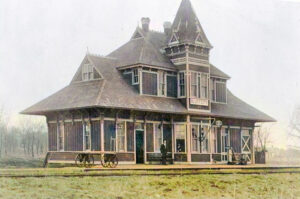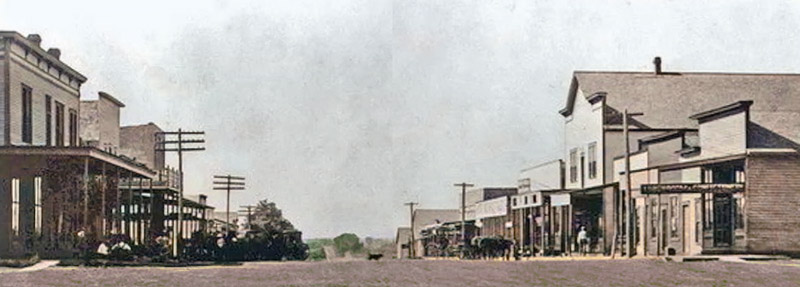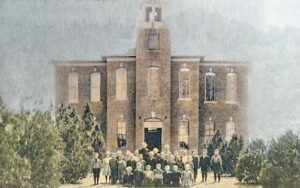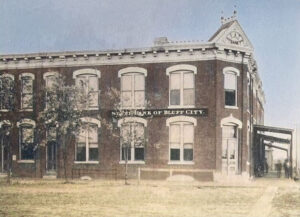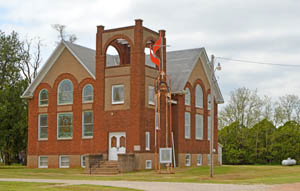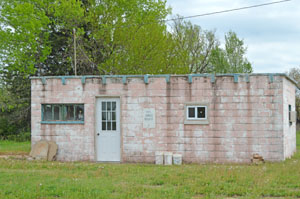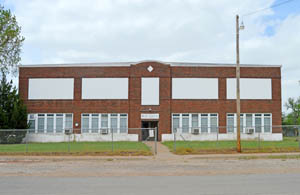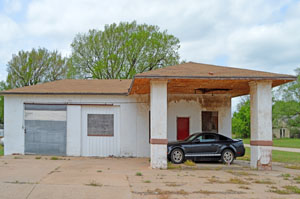
Bluff City, Kansas, courtesy of Google Maps.
Bluff City is a tiny town near Bluff Creek in southeast Harper County, Kansas. As of the 2020 census, its population was 45, and the city had a total area of 0.54 square miles, all of it land.
On October 6, 1886, James Glover pitched his tent on the present site of Bluff City. He came from Arkansas City, Kansas, in the interest of the Border Line Town and Land Company, of which James N. Young of Chicago, Illinois, was president and Edward P. Green was secretary.
The representatives of the Land Company were working in the interest of building and constructing the Southern Kansas and Western Railroad. The first depot was one of the finest on the line west of St. Louis, Missouri.
Bluff City was platted on November 10, 1886, and the first lots were sold that day. Four weeks later, $35,000 worth of lots had been sold, and about 200 men had moved in with their families. They were busily engaged in constructing about 40 buildings for the new town. A one-room school was built one-half mile south of the town. All building materials were hauled 16 miles by wagon from Caldwell, Kansas.
The first newspaper, the Tribune, was printed on December 10, 1886, with Will C. Barnes as the editor. It continued to be published until 1888.
The Border Line Town and Land Company erected a 30-room hotel with all its apportionments in four weeks.
Eleven acres were set aside for a park first named Walnut Grove but later changed to Glover Park in honor of James Glover, who did the landscaping and most of the planting of the trees and shrubs. Glover, James served as the postmaster for many years and Mayor of Bluff City for 16 years.
The 107-mile section of the road from Beaumont to Bluff City, known as the Bluff City Division, operated from the point. The railroad company’s improvements at Bluff City were most substantial, including a roadhouse, freight house, and car repair shops.
The Southern Kansas and Western Railroad merged with the St. Louis and San Francisco Railroad on January 1, 1887.
The post office was moved from the town of Bluff Creek on February 1, 1887. First called Bluff, Robert Echols was the first postmaster.
The Tribune newspaper was published from 1888 to 1890.
The town and post office names were changed from Bluff to Bluff City on January 28, 1890.
The Methodist Church was organized in 1891. Services were held in the old Hybsha Hall until a new church was built.
Members of the Christian Church held meetings in Pleasant Hill and Arnold schoolhouses. Later, a building measuring 24×20 feet was moved from Rome to serve the congregation.
The Independent newspaper published its first issue in 1891, which lasted until 1895.
Several families moved when the Cherokee Strip in Oklahoma was opened to settlement in 1893.
Between 1896 and 1910, Bluff City boasted a splendid band that held concerts in the park every other Sunday.
The Bluff City News began publication in 1897 under J.E. Grove and continued through 1918.
In 1902, Bluff City had a grocer, a bank; two feed, coal, and grain dealers; a physician; a general mercantile store; two lumber dealers; two real estate agents; a livery; two hardware and implement dealers; and several farmers and ranchers.
The one-room school was later replaced by a four-room, two-story brick building near the same site. The original brick structure was used for grade school and a two-year high school for several years.
Many people moved when the railroad shops and roundhouse were moved to Anthony.
A large portion of the business section of the town was destroyed by fire, as most of the original buildings were frame structures.
In 1910, Bluff City was an incorporated city of the third class and a station on the Kansas Southwestern Railroad. At that time, it had a bank, a weekly newspaper called the News, a money order office with one rural route, express and telegraph offices, a telephone exchange, good public schools, churches of some of the principal denominations, and well-stocked general stores. Its population peaked at 307. It was the principal shipping point between Anthony and Caldwell.
The Methodist Church was destroyed by fire on November 14, 1913. It was rebuilt and dedicated in December 1916.
The Messenger newspaper was first issued in 1921.
In the late 1930s, the banking facilities were moved to the Citizens National Bank in Anthony.
The Bluff City News was resurrected in 1931 by Mrs. Ed Strunk and published for over a quarter of a century until it was sold to the Anthony Republican on December 30, 1956.
A new Christian Church building was built in 1939.
Bluff City High School was closed in 1967 due to school unification. It now serves as a community building.
In 1968, the town’s elementary school had 49 students and six teachers, the post office on Main Street had one rural route, and its population was 135.
Today, the community is served by Chaparral USD 361 public school district in Anthony, Kansas.
The post office remains open today.
Bluff City is located 14 miles southeast of Anthony, the county seat.
©Kathy Alexander/Legends of Kansas, November 2024.
Also See:
Sources:
1884-1885 Gazetteer and Business Directory, R.L. Polk & Company, Detroit, MI.
1902 Patrons’ Reference, Standard Atlas of Harper County, George Ogle & Co., Chicago, IL., 1902.
Blackmar, Frank W.; Kansas: A Cyclopedia of State History, Vol I; Standard Publishing Company, Chicago, IL 1912.
Cutler, William G; History of Kansas; A. T. Andreas, Chicago, IL, 1883.
Harper County GenWeb
Sanders, Gwendoline & Paul; The Harper County Story, The Mennonite Press, Newton, KS, 1968.
Wikipedia

